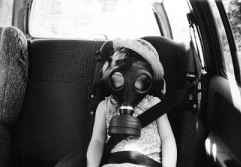The Urban Pollution Monitoring Project, a collaboration between several universities in England to develop mobile sensors that are geographically tracked and would draw a precise picture of how pollution affects urban spaces and the people within them.
The scenario would be as follows:
You’re walking down Main Street to the bus stop when you get a Bluetoothed message on your mobile saying “Would you like the pollution level for your location as of this moment?” You click “accept” and are informed that there is a carbon monoxide reading of 9.3 parts-per-million where you’re standing. For more information, you’re encouraged to visit a particular website.
Glancing around, you notice an official “Pollution Sensor” sign with a small electronic device strapped to it and an explanatory text, pointing to the same website. This website features a pollution map of your neighborhood. You see that just one street over from your daily path, the carbon monoxide reading is just 4.5 parts-per-million. From that day on, you steer clear of Main Street. One SMS enabled you to reduce your lungs’ daily dose of poisonous pollution with very little effort.
The researchers have already conducted a field study using prototype devices mounted on bicycles.
Within the next year, the team hope to contract with a manufacturer to produce small pollution sensors outfitted with GPS receivers and cellular transmitters. Volunteers would clip sensors on their clothes or bicycles and go about their daily routines. That data would then feed 3D visualizations for study by environmental scientists and city dwellers.
From The Feature, via Clippings.

Siemens researchers are working on a similar field as they have developed tiny sensors that can detect gases and smells.
Thanks to their small size (less than a millimeter), low production costs and economical energy consumption, these sensors are of interest for a large number of applications. Mobile electronic devices can indicate the ozone level in the air for people doing sports and emit a warning signal if the officially recommended limits are exceeded. Or if you’re out in the evening, the device can be used to measure the alcohol level in a person’s breath. The sensors can detect gas leaks in the home, at the work place or when traveling. Another area of application is as a fire detector as the sensor can send a warning before the fire really breaks out.
“I’m certain that in future many people will have their own personal warning device at home or take one with them when they travel,” says Siemens researcher Dr. Maximilian Fleischer.
Related: Pollution-detecting vests, Skirts for environmental awareness, bags with sensors.
